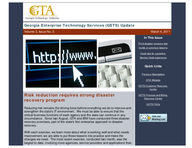Georgia Enterprise Technology Services (GETS) Update
Volume 3, Issue No. 3
March 4, 2011
In This Issue
Third disaster recovery test builds on previous lessons
Quick tips for a positive Service Desk experience
Quick Links
Risk reduction requires strong disaster recovery program
Reducing risk remains the driving force behind everything we do to improve and strengthen the state's IT environment. We must be able to ensure that the critical business functions of each agency and the state can continue in any circumstance. Since last August, GTA and IBM have conducted three disaster recovery exercises, part of the state's first enterprise approach to disaster recovery.
With each exercise, we learn more about what is working well and what needs improvement; we are able to put those lessons into practice and make the changes we need. The most recent exercise, conducted last month, was the largest to date, involving more agencies, service providers and applications than
Previous Newsletters
GTA Website
GETS Customer Resource Center
GETS Financial and Billing Resource Center
GETS FAQs
ever before. I hope you will read more about the exercise in this issue of GETS Update.
GTA is continuing to work with service providers to develop methodologies and tools to more effectively conduct future tests and to coordinate, track and resolve problems during disaster recovery exercises. With agency involvement, we will build the kind of disaster recovery program the state needs.
Thank you for your support.
Calvin Rhodes State Chief Information Officer GTA Executive Director
Third disaster recovery test builds on previous lessons
A six-day exercise last month marked the third disaster recovery test conducted since August. Each test has resulted in important lessons leading to stronger restoration capabilities.
The most recent test was the largest yet in both duration and scope. Beginning on February 8 and concluding on February 13, the test lasted 120 hours, exceeding the August (96 hours) and October (48 hours) exercises. Ten agencies participated, compared to nine in August and four in October. In addition to the highest agency participation, the test also had the largest number of participating service providers: IBM, AT&T Retail, AT&T Wholesale, and Dell all took part.
The test included 51 applications, topping totals from August and October (41 and nine, respectively). Last month's exercise was also the first to test T0 and T1 applications together. T0 applications are those that are to be recovered within 32 hours; T1 applications are to be recovered within one week. Six applications that previously failed were successfully restored.
Approximately 90 percent of all servers were restored, as opposed to 70 percent last August. In addition, many physical servers were restored to virtual hosts
during the test, requiring fewer physical servers for the exercise and allowing for more comprehensive testing.
Another first - IBM's Tivoli Service Manager (TSM) tool was used for the first time to recover applications for the departments of Juvenile Justice and Driver Services, whose servers are located at the state data center. TSM automates data backup and restore functions.
The test identified issues with servers that are clustered to support a single application due to size or complexity. Because restoration is more complicated in a clustered environment, a test environment or "sandbox" will be established at the state data center in preparation for subsequent testing.
The next test, a 150-hour exercise, is scheduled for August 2011.
Back to top
Quick tips for a positive Service Desk experience
The Consolidated Service Desk always aims to improve the service customers receive. Here are a few tips for getting issues addressed as promptly as possible.
Call after 11 a.m. The Service Desk is busiest between 7 a.m. and 11 a.m., so it's best to avoid those hours if possible. Of course, if you have a serious issue that is affecting your work, you should not hesitate to call at any time.
Be ready with key information. Service Desk agents will be able to help you more quickly when you can supply necessary information. In addition to the basics such as phone number and e-mail address, the agent may also ask for asset tag numbers (green tag on your computer), IP address, the number of workers in your area affected by the problem, etc.
Listen for messages. After you select the phone options, you may hear a recorded message about issues affecting parts of the network. If you hear a
message that applies to the issue you are calling about, make note of the referenced incident number so you can check back later for updates. It is not necessary to hold for an agent if your issue is already being addressed; doing so keeps other callers from getting through as quickly as possible.
Back to top
We welcome your comments about service delivery, the state's IT transformation and related topics.
You can submit comments online or call our toll-free number to leave a recorded message.
